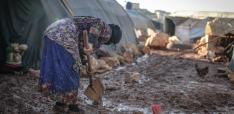Vaccine Chimeras

The overwhelming prioritization of vaccines takes attention and resources away from the complex political, social and infrastructural investments that underlie a resilient public health response.
In the last 12 months of the pandemic, the slogan of “we are all in this together” has pivoted towards a narrative of winners versus losers. Ironically, this has become more prominent precisely at the point when the race for vaccines is yielding initial promising results. Not for the first time, the terrain of pharmaceuticals serves as a battleground that reveals inequities in global health.
As has often been noted, over 60% of vaccine doses have been pre-ordered, including most of the 2021 manufacturing capacity for the leading candidates, by a handful of wealthy countries that account for less than 12% of the world’s population. This is similar to how personal protective equipment was bought up by a few rich countries in the early months of the pandemic. What has been remarkable is the air of inevitability that has been accorded to this “vaccine nationalism,” rendering somewhat hollow recent exercises around sustainable development goals, global compacts, and universal healthcare. Even as the spread of the coronavirus across borders underlined the globalized nature of our world, the response to the pandemic, in its failures and successes, has reasserted the centrality of national governments. “Global health” of the 21st century, with its emphasis on non-state actors and shared ethics, might be reverting to an era of “international health” which puts the nation-state back at the center.
Some alternatives to the stridency of vaccine nationalism are found in initiatives that seek to create access to medicines for poorer countries. A couple of these ventures introduced by nations in the global South, such as the World Health Organization’s (WHO) COVID-19 Technology Access Pool and a more recent proposal from India and South Africa at the World Trade Organization, haven’t met with support from the wealthiest countries. In contrast, much has been made of the efforts of the Gates Foundation that has edged aside the WHO to take the lead in creating platforms for international vaccine development and distribution. Precisely because of the disproportionate resources, media attention, and political cache granted to Gates’ initiatives such as COVAX, we need to ask how these platforms are being designed, who is at the table in determining priorities, and the explicit and implicit trade-offs that are being made. It is the last point that I want to focus on—of trade-offs incurred by donors’ focus on vaccines, and how they might be re-inscribing global health inequities.
The biggest trade-off incurred by the overwhelming prioritization of vaccines lies in the attention and resources taken away from all the other fundamentals that underpin a resilient response to a pandemic. Vaccines have undoubtedly been an important part of the armamentarium to combat past epidemics, and they will play a key role in curtailing COVID-19. Nonetheless, the unbridled enthusiasm for vaccines at the cost of all other measures should give us pause. COVID-19 has vividly illustrated the importance of equitable and accessible health systems, broad state capacities, capable leadership, and public trust of experts and government; these intangible and tangible factors, braided together, allow a society to successfully address a public health crisis. And yet the Gates Foundation, much like the United States government, has a single-minded focus on vaccines and therapeutics. The vaccine is heralded as the magic bullet that is going to deliver pre-COVID normalcy to the world. Using its considerable bully pulpit, the foundation has convinced many donors to contribute to COVAX which in turn is resulting in a diversion of COVID-19-related aid originally intended for broad-based health system strengthening in less wealthy countries. These trade-offs, often made in board rooms behind closed doors, will be difficult to count and account for, and yet need to be flagged for they put global health programs on a trajectory that has a history of failures and limitations.
To defend the focus on vaccines, advocates point to the success of older vaccines, especially the small pox vaccine, in eradicating disease. And yet this is a selective reading of a messy history. International health is littered with examples of how difficult it is to run immunization campaigns, and how sustained success demands a lot more than an effective technological product. The long and mixed history of tuberculosis control is replete with lessons about the risks in launching campaigns with new technologies. Recent polio vaccination campaigns in many countries have frequently elided their targets because people on the ground have mobilized resistance; this despite significant funding and fundraising from donors such as the Gates Foundation. Efforts to control outbreaks of Ebola in Africa, including through a new vaccine, offer their own sobering caveats. These campaigns attracted well over a US$1.5 billion in donor aid over the last few years. However, by most accounts, the significant influx of funds has left little legacy infrastructure, with the monies being used up in narrow vertical programs that funded international consultants and purchased targeted equipment that could not be easily repurposed.
The takeaway, then, from the history of immunization programs is not of easily replicable success of the small pox vaccine. Rather, it is that for immunization programs to work, there have to be functioning and accessible health systems that are trusted by the population. The specific biological challenges of the pathogen matter, as do committed leadership, able management, and broad-based social support structures. Moreover, there is a danger that narrowly defined vertical programs become one-shot investments that do not build overall health systems. In contrast, investing in broader health systems enables the success of not only a particular immunization campaign but also a society’s ability to respond to future public health problems. Tellingly, countries like South Korea, Thailand, Vietnam, Taiwan and Japan, that have successfully managed the pandemic, consider vaccines as only one tool in their larger public health armamentarium; they have largely relied on their robust health infrastructures and vast state capacities. Even China, a leader in vaccine development, is using the technology more as a geopolitical instrument than the mainstay of its domestic public health strategy to control the epidemic.
This tussle—between the relative merits of an integrated approach to health and horizontal health systems versus narrow vertical disease programs that heavily lean on biomedical technologies to control diseases one at a time—is an old debate in international health. Indeed it has played out many times before: the 1978 milestone of the Alma Ata declaration underlined the importance of primary health for all through an emphasis on equity, community participation, broad-based healthcare systems and human rights. In a few short years, however, the Rockefeller Foundation and allies decried such an approach as unfeasible and successfully pushed funding into targeted programs under the umbrella of “Selective Primary Healthcare.” Decades later, the more ambitious human rights based Universal Health Care mandates of the SDG process were overtaken by discrete goals and measurable targets of vertical programs. In this longstanding debate, international health institutions, be it older actors like UNICEF and the World Bank, or newer players like GAVI and the Global Fund, have mainly prioritized vertical disease programs. Their structures of funding and the modes of accountability that they demand keep bringing them back to strategies based on siloed vertical programs, creating the groundwork, time and again, for some discrete successes and many widespread failures.
Vaccines and targeted vertical programs have often been defended as necessary tools for combating emergencies. But the sad truth is that global health is increasingly viewed as a series of emergencies. In this schema, there is never a good time for donors to invest in broader health systems. Rather, they episodically fund new technologies and targeted disease programs while under-resourced governments are held responsible for building public health systems. Ironically, even the most successful global social movements in health, such as evidenced during the AIDS pandemic, have focused on targeted campaigns for access to medicines rather than a more integrated approach to improving health. This script is playing out once again in COVID times, with overwhelming attention to vaccine development and distribution remaindering a host of other alternatives of how to invest in health.
How does one break out of this cycle of donor-driven siloed funding in global health to lay the groundwork for more sustained wellbeing? How does one interrupt the recursive self-validation of vertical programs—where the number of vaccine doses rolled out will be quickly equated to a count for number of lives saved—with no sense of trade-offs or alternatives that might have worked better? In the earliest essays of Pandemic Discourses, Carlos Lopes argued that COVID-19 should serve as an accelerator for long-postponed structural change in health systems in Africa, and Celso Amorim and Luiz Inácio Lula da Silva made a clarion call for a new multilateralism. Alternatives to the extant dispensation in global health can also be found in studying the countries that have successfully controlled the COVID-19 pandemic. In her recent letter from Tokyo, Sakiko Fukuda-Parr discussed the role of longstanding public health infrastructure as key to Japan’s successful response. In the coming months in Pandemic Discourses, we hope to publish more such studies from parts of the world where health has been understood as responsive not merely to technological solutions but inextricably a result of longer term political, social and infrastructural investments. It might well be that to learn those lessons, global health enterprises should be taking their cues from Seoul rather than Seattle.
Manjari Mahajan is an Associate Professor in the Julien J. Studley Graduate Programs in International Affairs and the Co-Director of the India China Institute at The New School.
This first appeared on the Pandemic Discourses blog and was repsted at the author's request.
Photo by RF._.studio from Pexels


